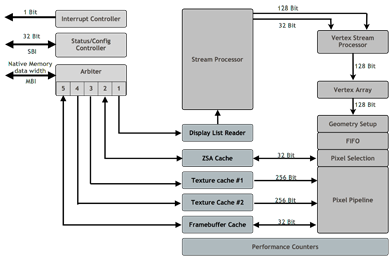D/AVE 3D - OpenGL ES 1.1 3D graphics IP core for FPGAs and ASICs
D/AVE 3D is cost-efficient IP core for 3D graphics applications. This core is available for FPGAs, ASICs and SOCs, specifically designed for the embedded, automotive and infotainment market with a big emphasis on flexibility both in hardware and the software.
D/AVE 3D Features
- Low resource usage
- Low gate count ( ~1Mio. Gates for ASIC)
- Low internal memory requirements ( ~125 K Memory Bits)
- 70K Logic elements for FPGAs
- Offers a wide range of graphical primitives
- Lines, Triangles, Quadrangles
- Prepared for easy SoC integration
- ALTERA AVALON support
- ARM AMBA-AHP, ARM AMBA-APB Bus support
- Performance robust to high memory latency
- Single clock domain architecture
- High Performance
- 100 Mio. Pixels/Second fill rate (100 MHz).
- 6,6 Mio. triangles throughput (100 MHz.)
- Early-Z-Test
- High Quality Rendering
- Anti-Aliasing and Sub-Pixel accurate rendering
- Edge-Based-Filtering for image scaling
- Per-Primitive-Anti-Aliasing (settable per edge)
- Static dithering at Framebuffer write back to enhance RGB565 output
- Fully programmable Transform and Lighting Engine
- Textures
- 2048 x 2048 Texture size
- Flexible texture color format handling
- Texture compression
- Texture offset swizzeling
- Framebuffer
- 2048 x 2048 supported
- ARGB8888, ARGB4444, ARGB1555, RGBA5551, RGB565, AL88, AL44, A8
- Blend Modes - Blend, Multiply, Darken, Lighten
APIs
D/AVE 3D is provided with the following APIs. The drivers are reentrant and OS agnostic.
- EGL 1.3 API
- OpenGL ES 1.1 API
- OpenVG 1.01 API
Architecture
The system interfaces to D/AVE 3D are very simple. In the Altera world it supports all bus interfaces available on Avalon bus architecture. In the SOC world AMBA is supported and additional bus wrappers are easy to implement with the interfaces to D/AVE 3D being very simple Master, Slave and Interrupt lines. After reset the CPU can configure or can get status information via the SBI (Slave Bus Interface) with data and memory access through the master bus interface.
To deal with unpredictable memory latency, FIFOs are added at all crucial places, which makes D/AVE 3D more performance robust. The pixel pipeline supports early Z-test. D/AVE 3D in a SOC supports multiple pixel pipelines.
Performance
All performance data given are made under the following assumptions:
- 100% cache hit rates
- No latency from external data
- Internal pipeline latency ignored
- 100 MHz.
Fillrate
The Pixel-Pipeline of the D/AVE 3D-IP can produce 1 pixel per cycle, in any configuration.
Vertex Throughput
The vertex throughput depends very much on how many light sources are enabled and if transformation is performed. It also depends on the associated vertex attributes, such as color and texture coordinates.
| Transformation | Lighting | Shade Model | Texture Coordinates | Performance (Vertices Per Second) |
|---|---|---|---|---|
| - | - | Flat | - | 33 Mio. |
| 4x4 Matrix | - | Flat | - | 6,6 Mio |
| 4x4 Matrix | - | Smooth | - | 6,25 Mio. |
| 4x4 Matrix | - | Smooth | S, T | 5,8 Mio |
| 4x4 Matrix | 1xDiffuse 1xAmbient | Smooth | - | 0,3 Mio. |
Triangle Throughput
The triangle throughput depends very much on the number of attributes, which have to be interpolated across the primitive.
| Z-Buffer | Vertex Colors | Texure Coordinates | Performance (Triangles Per Second) |
|---|---|---|---|
| - | - | 6,6 Mio. | |
| x | x | - | 5,2 Mio. |
| x | - | S1, T1 | 6,6 Mio. |
| x | x | S1, T1 | 4 Mio. |
| x | x | S1, T1/ S2, T2 | 3,5 Mio. |
Related Links
- Eval kit and more information: Please contact graphics@tes-dst.com
- Support : dave_support@tes-dst.com
- Sales: graphics@tes-dst.com



